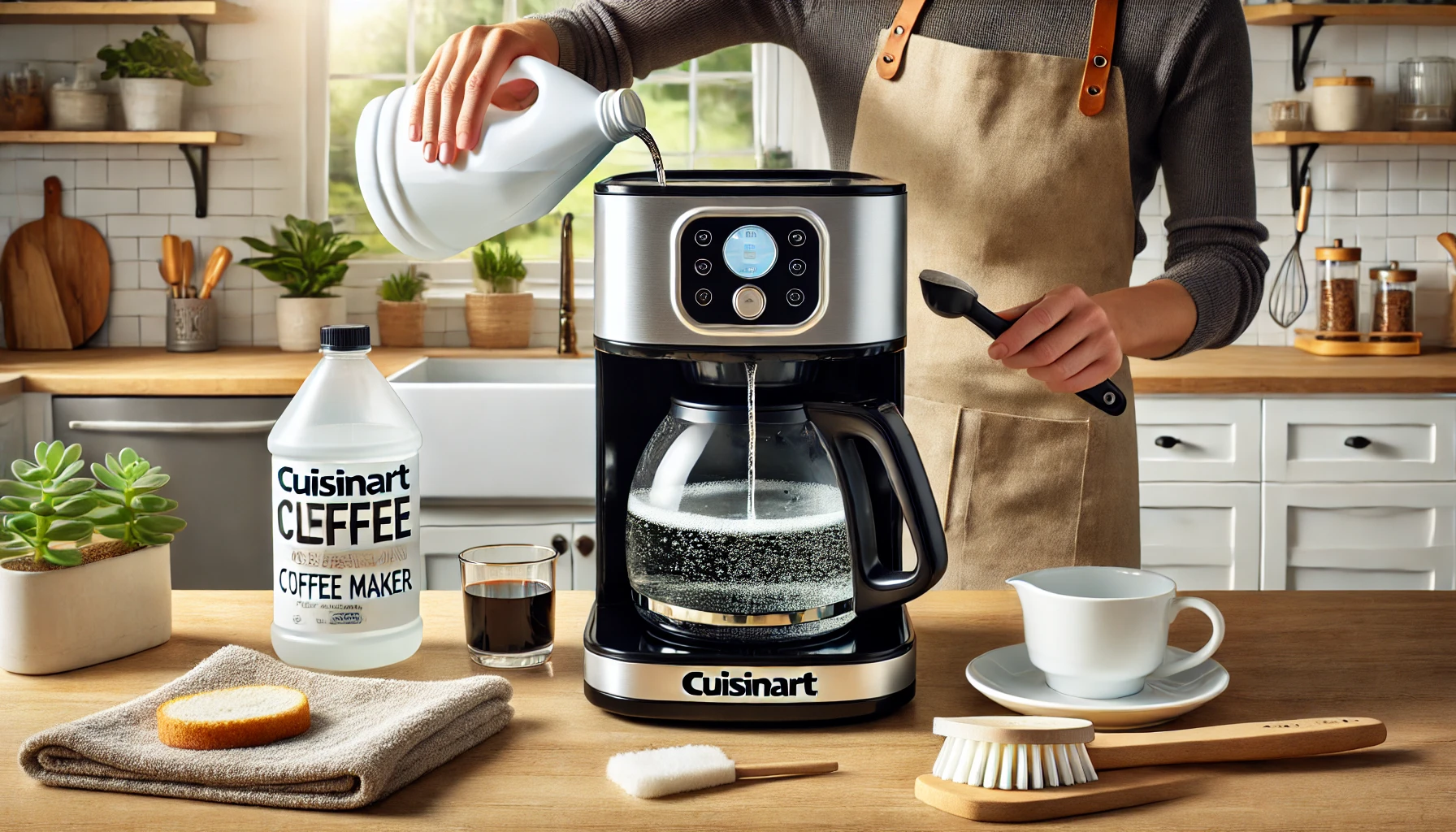If your morning coffee has started tasting a little off, or your Cuisinart coffee maker is taking longer to brew, chances are it needs a good cleaning and descaling. Over time, mineral buildup from water can clog the internal components, leading to poor performance and even machine damage. But don’t worry—cleaning your Cuisinart coffee maker is easier than you think!
In this guide, we’ll walk you through the best way to clean and descale your coffee maker using simple, effective methods. Whether you prefer natural solutions like vinegar or a specialized descaling solution, we’ve got you covered. Let’s dive in and get your coffee maker back to brewing the perfect cup!
Why Cleaning Your Cuisinart Coffee Maker is Essential
Think about it your coffee maker runs water through metal tubes and a brewing system every single day. Over time, calcium and limescale deposits from hard water build up inside the machine, affecting the taste and quality of your coffee.
Here’s why regular cleaning is a must:
- Better-Tasting Coffee – Old coffee oils, mineral buildup, and moldy residue can make your coffee taste bitter or stale.
- Longer Machine Lifespan – A well-maintained coffee maker lasts much longer and performs better.
- Faster Brewing Time – Mineral deposits can slow down water flow, making your machine work harder.
- Prevents Bacteria & Mold – Coffee makers are warm and damp, the perfect breeding ground for bacteria. Regular cleaning keeps things sanitary.
How to Know When It’s Time to Descale
Not sure if your Cuisinart coffee maker needs descaling? Here are some telltale signs:
- Your coffee tastes different – A sour or bitter taste often means buildup inside the machine.
- Brewing takes longer than usual – If it’s taking forever to fill a cup, mineral deposits could be clogging the system.
- Loud or unusual noises – If your machine is gurgling more than usual, it might be struggling with blockages.
- The “Clean” light is on – Many Cuisinart models have a self-cleaning indicator. When this light turns on, it’s time to descale!
See more: Keurig Priming Instructions: How to Fix the ‘Prime’ Error
What You Need to Clean and Descale Your Cuisinart Coffee Maker
Before you start, gather these simple household items:
- White vinegar – A natural and cost-effective descaling solution.
- Water – To dilute the vinegar and rinse the machine.
- A soft cloth or sponge – For wiping down the exterior.
- Dish soap – To clean removable parts like the carafe and filter basket.
- A descaling solution (optional) – If you prefer a commercial cleaner over vinegar.
Now that you have everything ready, let’s go step by step to get your coffee maker sparkling clean!
Step 1: Daily Cleaning Routine
Keeping your coffee maker clean daily prevents buildup and extends its life. Here’s what you should do after each brew:
- Empty and rinse the carafe – Don’t leave leftover coffee sitting in the pot all day. Rinse it out with warm water.
- Clean the filter basket – Remove the coffee grounds and wash the basket with mild soap and warm water.
- Wipe down the exterior – Coffee spills can stain the machine. Use a damp cloth to clean the outside.
- Leave the lid open – Letting your coffee maker air dry prevents mold growth inside.
A little daily maintenance goes a long way in keeping your coffee tasting fresh!
Step 2: Deep Cleaning Your Cuisinart Coffee Maker
Even with daily cleaning, coffee oils and mineral deposits still build up over time. A deep clean is recommended at least once a month.
Cleaning the Removable Parts
Start by taking apart the machine:
- Remove the carafe, filter basket, and water reservoir (if removable).
- Wash them with warm, soapy water and rinse thoroughly.
- Let them air dry before reassembling.
Cleaning the Coffee Maker’s Interior
To remove coffee stains and prevent bacteria buildup, follow these steps:
- Fill the water reservoir with a mixture of half water and half white vinegar.
- Run a brew cycle without coffee grounds. This allows the vinegar to break down mineral deposits inside the machine.
- Pause halfway through the cycle and let the vinegar sit for 30 minutes. This helps dissolve stubborn limescale.
- Complete the cycle and discard the solution.
After the vinegar cycle, run two or three full cycles with fresh water to remove any lingering vinegar taste.
Step 3: Descaling Your Cuisinart Coffee Maker
Even if you regularly clean your machine, minerals from water will eventually build up inside, affecting performance. Descaling removes these stubborn deposits and ensures that your coffee maker brews efficiently.
Using White Vinegar to Descale
White vinegar is one of the best and most affordable ways to descale a coffee maker. Here’s how to do it:
- Prepare the descaling solution – Mix equal parts white vinegar and water. For most models, you’ll need about 4 cups of each.
- Pour the solution into the reservoir – Make sure the machine is empty before adding the mixture.
- Run a brew cycle – Start a full brewing cycle without coffee grounds. If your Cuisinart coffee maker has a self-clean function, press that button instead.
- Pause halfway through – When the cycle is halfway done, turn off the machine and let the solution sit for 30 minutes. This helps break down calcium and limescale deposits.
- Resume and complete the cycle – Turn the coffee maker back on and let it finish brewing.
- Flush the system – Run at least two full cycles with fresh water to remove any leftover vinegar taste.
After this, your coffee should taste fresher, and your machine should run more smoothly.
Using a Commercial Descaling Solution
If you don’t like the smell of vinegar or want a specialized cleaner, a commercial descaling solution is another great option. These are designed specifically to dissolve hard water buildup without harming your machine.
- Follow the instructions on the product – Each brand will have slightly different dilution ratios.
- Add the solution to the water reservoir – Make sure the machine is empty before doing this.
- Run a full brewing cycle – Let the solution work its way through the machine.
- Rinse thoroughly – Just like with vinegar, you’ll need to run two or three fresh water cycles to clear out any residue.
These solutions are especially useful if you have very hard water, which causes faster mineral buildup.
Step 4: Maintaining Your Cuisinart Coffee Maker
Now that your machine is clean and descaled, keeping it that way is important. Here are some simple maintenance tips:
Daily Maintenance
- Empty and rinse the carafe after every use. Don’t leave coffee sitting inside, as it can stain the glass.
- Clean the filter basket to prevent old coffee residue from affecting the taste.
- Wipe the exterior with a damp cloth to keep it looking fresh.
Weekly and Monthly Cleaning
- Check the charcoal water filter. If your model has one, replace it every 60 days, or sooner if you use the machine daily.
- Deep clean the carafe and removable parts with warm, soapy water to prevent coffee stains.
- Descale every 1-3 months depending on water hardness and usage.
If you drink coffee daily, keeping up with these maintenance steps will ensure your Cuisinart coffee maker stays in top condition for years.
Troubleshooting Common Issues
Even with regular cleaning, sometimes issues can still arise. Here are some common problems and how to fix them:
1. My Coffee Maker is Brewing Too Slowly
This is usually caused by mineral buildup. Run a descaling cycle with vinegar or a commercial descaler to clear the blockages.
2. My Coffee Tastes Bitter or Burnt
Old coffee residue and oils might be lingering. Make sure you’re regularly washing the filter basket, carafe, and interior parts.
3. The Self-Clean Light Won’t Turn Off
If the cleaning indicator light stays on even after a cleaning cycle, try running another cycle with fresh water. If that doesn’t work, unplug the machine for a few minutes, then restart it.
4. My Coffee Maker is Making Gurgling Noises
This is another sign of scale buildup. Descale the machine, and if the noise persists, check that no coffee grounds are clogging the water lines.
Conclusion
Keeping your Cuisinart coffee maker clean and descaled is the key to consistently great-tasting coffee. A little maintenance goes a long way in ensuring that your machine runs smoothly and lasts for years.
By following this step-by-step guide, you’ll prevent mineral buildup, improve your coffee’s flavor, and keep your machine in peak condition. So, the next time your coffee starts tasting off, don’t rush to replace your machine—just give it a good cleaning!
I’m Jeff Olson, and I love coffee. In fact, I’m something of a professional about coffee. I own and operate coffeemachinenes.com, one of the web’s top resources for everything coffee-related. I’m also an avid home barista, and enjoy experimenting with different brewing methods and flavor profiles. When I’m not nerding out about all things coffee, you can find me playing guitar or spending time with my wife and kids.

